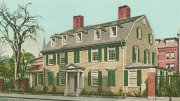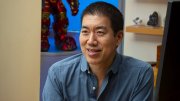
Photograph by Harrison
Janet Browne
When Darwin biographer Janet Browne emigrated from University College London a year ago to become Aramont professor of the history of science, she first lived in Harvard housing built in the former botanical garden of Asa Gray, the first Fisher professor of natural history and an early and forceful proponent of Darwin’s theories. “There are still trees there with his identifying tin medallions,” she says. “All the streets are named after botanists. Fancy walking to work down Linnaean Street!” She teaches a Core course on the Darwinian revolution and another, on the history of biology, that begins about 1650 with early natural-history collecting. Next semester she’ll explore nature on display—in museums, zoos, on TV. She appears here with a gorilla shot in 1926-27 by the Museum of Comparative Zoology’s Harold Coolidge and mounted looking ferocious, as was thought appropriate for gorillas. (Gorilla gorilla had been named by Harvard’s Jeffries Wyman in 1847, based on bones sent from Africa.) She suggested the setting because she is at work on a visual and cultural history of the gorilla. (She will not overlook King Kong.) Browne has spent 17 years with Darwin, winning plaudits, literary and scholarly prizes, and pleasure. She was associate editor of his correspondence and then wrote a magisterial two-volume biography: Charles Darwin: Voyaging (1995) and Charles Darwin: The Power of Place (2002). “He was great to live with,” she says. “I would get up, quite early, get the children off to school, everybody out of the house, turn on my computer, make a cup of coffee, and then I was with Darwin all day. It was lovely.”





